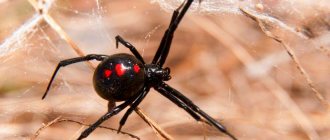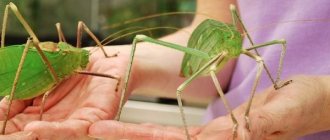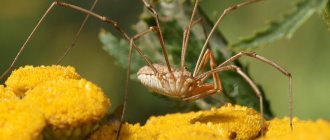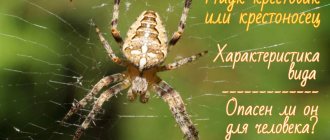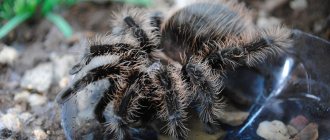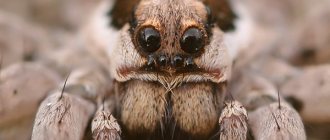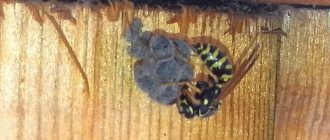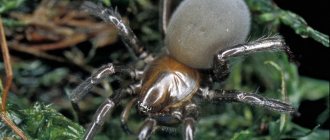Few will be surprised to learn that the fear of spiders is one of the most common among people. After all, these mysterious creatures are so similar to us. Perhaps irrational fear comes from our ancestors. After all, in ancient times, a spider bite significantly reduced the chances of survival.
And the appearance of these arthropods is simply unpleasant for many. In total, the order includes 42 thousand species, which are distributed everywhere. Almost all spiders are predators.
Despite all the dislike for spiders, people are often guided by myths rather than common sense. As a result, these false beliefs create even more fear. Isn't it time to debunk the main myths and misconceptions about spiders?
All spiders weave webs
It seems natural to us that spiders have eight legs, eat flies and catch prey using their webs. In fact, this method of catching prey is characteristic of only half of the representatives of the order. Other spiders prefer active hunting. For example, wolf spiders stalk their prey like other animals. But trapdor spiders build special holes with hatches where they hide. As soon as the vibrations of the signal threads make it known that prey is approaching, the creatures immediately jump out of ambush and grab the victim. Other spiders do not weave a web, but shoot it either directly at the prey, immobilizing it, or even throw it into the air so that it flies freely, and maybe catches someone. People believed that all spiders made webs, since this light mesh can be found much more often than a spider that will attack a person by shooting webs at him.
Is it worth getting rid of them?
There is also damage from spiders. They frighten sensitive people, leading some to arachnophobia. Cobwebs do not add attractiveness to our apartments.
What is greater in each specific case - benefit or harm, each of us must decide for ourselves. And then you have to choose between peaceful coexistence or constant struggle with arachnid neighbors.
When Heiraknatum Milde bit my nephew, I decided to take out all the spiders. P.S. my nephew was in the hospital for 3 days.
Are chemicals used to combat spiders dangerous if there are small children in the house? I try to remove them in every way, but sooner or later I see the web again, I collect it, and then it appears again in other places.
Olga, of course dangerous!
The article says that spiders live in dry and warm rooms. But in my case, on the contrary, these arthropods live in the bathroom, where, in principle, on the contrary, it is always humid. I don’t fight with anything, I just wash it off with water. But the feeling is not pleasant. Can you tell me what might benefit them here?
Most likely they are attracted to a dark place.
I have arachnophobia, so I can’t stand being around farts even though I mentally understand that they are useful and harmless creatures. I usually remove spotted spiders, as well as their webs, using a vacuum cleaner. I also try to regularly clean the secluded corners where they tend to settle. The ventilation holes were sealed with a mosquito net - it allows air to pass through and at the same time does not let in uninvited guests. I didn’t know about chemical means to control these insects. Just in case, I'll take note. I don’t like chemistry, but I don’t like spiders even more))).
I’m very afraid of spiders, especially big ones. I recently saw one of these on the ceiling of a house. I was afraid to approach it for a long time, but then I finally knocked it out with a rag, even though I didn’t want to kill it. Apparently, you will have to install mosquito nets on the windows and ventilation holes.
I am very, very afraid of these creatures. I recently caught a very large spider, I’ve never seen one like this before, I don’t know what to do, I’m afraid that there may be more such “neighbors”. I’m afraid that they can cause some harm to my children (((What should I do.
Can perfectly healthy kittens die from a spider bite? Recently my second kitten died suddenly. The same incident happened 3 years ago. This summer I even saw a karakurt in my garden. The house is private, wooden. Spiders are common, but they are common “house” ones. In winter, my cats go to the toilet in the basement. Maybe there are poisonous spiders hiding there? Or can ordinary spiders in some cases be poisonous? What if you burn several sulfur briquettes in the underground in winter - will it work?
No shit now, remove all the furniture and clean, clean, wash everything for the hell of it!
I have these crawling out of my ventilation, it’s scary to open it and clean it, in case I come across a “family” of them.
Spiders can build nests in a person's head
This myth is no longer so popular nowadays, although many people believed in it in the 1950s. After all, then lush hairstyles in the form of a cocoon or a beehive came into fashion. They were so complex that they were difficult to care for and wash. So people began to believe that spiders would be happy to build their home in such a cozy place. Spiders actually don't like living in human hair. Most of them are too big to move around comfortably. And beehive hairstyles will make the task of moving even more difficult. After all, the accumulation of hair is present in one place. And the hair constantly flies away, which does not add comfort to the spiders.
Spiders never get caught in their own webs
This assumption seems logical, because in webs we usually see flies, but not spiders. They seem to have some kind of immunity to their own stickiness. In fact, spiders do not have this quality. They just move extremely carefully along the network to avoid getting stuck there. And contrary to another myth, not all webs are sticky. Some nets have small scattered drops of glue. As a result, the spiders simply do not step on them, realizing the danger. Scientists suggest that the unique design of the spider’s legs also helps avoid falling into its own traps. Either a special liquid is released from them that dissolves the glue, or there is a special device present. In general, spiders know very well the structure of their labyrinth, which threads are dry and which are sticky, choosing the optimal route.
It is better not to kill a domestic spider, but simply throw it outside
What is the first reaction of a person who sees a spider at home? Kill him with a newspaper! True, there are more merciful people who carefully take the spider and take it outside. It seems that everyone will benefit from such a step - the person will get rid of the dangerous creature, and the spider will return to its natural environment. In fact, most likely the arthropod will simply freeze. After all, most of these spiders have spent their entire lives indoors; they are simply not adapted to life in the open air. This is especially true for Europe. Although people are afraid of some types of spiders, the creatures living in the house are harmless to us. They can't even bite through the skin. So, with good intentions, the spider can simply be killed in a more sophisticated way.
Reasons for appearance
The main habitat of insects is gardens, forests, orchards and trees. They build nests on plants and weave webs there.
The main reason why house spiders appear in residential areas is an abundance of suitable food. Adults are voracious, so they settle wherever there is a sufficient number of flies, cockroaches, mosquitoes and beetles.
Another factor that provokes the dispersal of creatures is suitable living conditions in terms of temperature and humidity.
Spiders love darkness, coolness and high humidity. In an apartment or house, insects settle behind radiators, on the back walls of furniture, and in the bathroom. Frequent destruction of the web forces predators to change their habitat.
More often, small animals can be seen in houses with damp foundations. Spiders do well in damp and dark rooms.
Creatures enter a person’s home through windows, doors, or the basement. People can bring an unwanted guest on clothes or with food (vegetables, fruits). If the home does not have conditions suitable for the insect, then it is unlikely to stay long.
Spiders can lay eggs under human skin
There is a legend about a man who was bitten by a spider in an exotic country. Returning home, the traveler discovered that the bite site began to swell, and as a result, many small spiders burst out. Is it really scary? In fact, this legend has nothing in common with reality. Some other creatures, such as wasps, can actually lay eggs inside other animals. But spiders simply do not have the means to achieve such a goal. Not only do they, in principle, not have the necessary capabilities to accommodate their offspring in a person, but also the choice of a place to store eggs is very scrupulous. Spiders prefer secluded and protected places where their offspring will not be threatened. Placing eggs under human skin would mean the death of the spiders immediately after hatching - who would tolerate that?
What determines the number of spiders at home?
If you do nothing, then one fine (or rather not so fine) day there will be a lot, a lot of spiders in the house. Arthropods at home can live for many years and reproduce well. Sometimes you can see newborn spiders leaving the clutch. Having hatched from the egg, small spiders are immediately capable of independent life and scatter away from the “parental” nest. Each spider weaves a new web, grows, and upon reaching sexual maturity, increases the number of tenants. So after a certain period of time there will be a lot of spiders in the apartment.
Attention! To lay eggs, the female often chooses a quiet place where the spiders will not be in danger before hatching:
There is certainly some spider at a distance of a meter from us
This myth originated with archaeologist Norman Platnick, who in a 1995 article stated that “anywhere a person is within a few meters of him there is likely to be some kind of spider.” While it's hard to imagine exactly how many spiders there are in the world, it's absurd to think that you can't lie down or walk a few steps without being in their company. People took this statement as a fact, and now they are speculating on it. And “several meters” was changed to “meter”, and the word was probably discarded altogether. In 2001, this statement was already cited in books as a fact.
Why do spiders appear in a house or apartment?
Human housing provides many suitable corners for spiders. Spiders have adapted to live in different conditions, and a comfortable apartment is a much safer place than the conditions of a forest or city street. There are several reasons why spiders appear in the house.
In order for these eight-legged arthropods to appear in a home, unsanitary conditions and an abundance of insect pests are necessary.
Female black widows eat their males
This opinion does not correspond to reality. Most likely the reason is a misinterpretation of what is happening. It is believed that female black widow spiders actually eat their males. This is how the term “black widow” even appeared, which refers to an extremely suspicious or angry woman. In fact, if this happens, it is not at all as often as it seems. First of all, there are several varieties of “black widows”, and only some of them are engaged in eating their relatives. And even in this case, this happens as a result of hunger, which is a good excuse for them. Black widow males are much smaller than females - almost 4 times. When mating, spiders are very close to the mouth of a hungry female. Avoiding temptation is quite difficult, but quite possible. Thus, an insignificant fact received much more fame than it should have. Other habits of spiders, sometimes even more repulsive, have remained “behind the scenes” in popular culture.
Description and features
Spiders are very interesting representatives of the biological kingdom, and some of them are far from harmless. They also have an amazing structure. Some varieties of these creatures have special appendages in their mouths, the so-called jaw claws.
These include araneomorphic spiders - members of a large group of arachnids. These natural adaptations are called chelicerae. They allow these creatures to successfully attack prey that is quite large in comparison with their size, which gives them the opportunity to win the evolutionary race.
The cross spider is one of these creatures - a striking specimen from the orb-weaver family.
This creature earned its name not by chance, but because of a very noticeable feature - a mark on the upper side of the body in the shape of a cross, made up of white, in some cases light brown, spots.
The spider got its name from the color on its body that resembles a cross.
This appearance feature turns out to be very useful for these biological organisms. This gift of nature is a sign that can scare away many hostile living beings. The remaining characteristic features are clearly visible in the photo of the cross spider .
As you can see, it has a rounded body. It turns out to be almost integral with the head, dividing into two areas, which are usually called the cephalothorax and abdomen.
The size of such living creatures cannot be considered too large. For example, females, which are more impressive in size than males, are usually no larger than 26 mm, but there are specimens of such spiders that are only a centimeter long and much shorter in length.
In addition, the cross is endowed with eight sensitive flexible legs. He also has four, paired, eyes. These organs are located diversified, which allows this animal to have a 360-degree view in all directions. However, these biological organisms cannot boast of particularly acute colorful vision.
They distinguish only the outlines of objects and objects in the form of shadows. But they have quite good senses of taste and smell. And the hairs covering their body and legs perfectly capture a wide variety of vibrations and vibrations.
Chitin, a special natural binding compound, serves as the covering of the body and at the same time a kind of skeleton for such creatures. From time to time it is shed by these arachnids, replacing it with another natural shell, and during such periods the growth of the organism takes place, freed for a time from the elements that constrain it.
The cross spider is considered a poisonous spider, but its poison is not dangerous for people
This representative of the biological kingdom of arachnids is capable of secreting a substance that is toxic to all types of organisms. So is the cross spider poisonous or not ? Without a doubt, this small creature is dangerous to many living things, especially invertebrates.
And the poison they secrete has an extremely detrimental effect on their neuromuscular organization.
Every year, people unintentionally swallow several spiders.
This is another statement that many people believe. It is quite difficult to refute it from a scientific point of view. And this myth was born thanks to Lisa Holst. She decided to prove that people are ready to believe everything that is printed on the Internet. That's why she emailed a bunch of fake facts to her friends. The story about swallowing spiders became her pride - they believed in it the most. Lisa found this story in a book called Insect Facts and Legends. However, swallowing spiders is a fictional story. People are ready to believe any scary story; it quickly spread across the Internet.
The most poisonous spider is the haymaker
This myth is complemented by the reassuring fact that a spider cannot bite through human skin. In fact, it is worth noting that there is no real haymaker, there are many different creatures united by this name. Some of them are actually insects, not spiders and certainly not poisonous. The same spider that bears this name is harmless to humans. “MythBusters” even performed an experiment - the tester’s hand was bitten, but the person only felt a weak and rapid burning sensation. And the analysis of the poison showed that the “black widow” has it stronger.
Is it good or bad?
On the one hand, if spiders appear in an apartment, they are capable of destroying the pests living there. On the other hand, the networks they weave, and the very sight of many-legged creatures, can please few people. In advanced cases, there can be so many cobwebs that the home takes on a neglected, uninhabited appearance.
Spider-Man is certainly more afraid of him than he is of them. Arthropods will never hunt or specifically attack people. The spider flees from large opponents.
There are huge camel spiders
There are real legends surrounding the creatures that live in deserts. And it’s all because of messages on the Internet that announced the discovery of the Iraqi camel spider. They say that it reaches 30 centimeters in length, can live in the stomachs of camels, run at speeds of up to 40 km/h, and make a loud noise. Naturally, there are myths about the extremely poisonous nature of camel spiders; supposedly because of this, one of the peacekeepers in Iraq even died. In fact, these creatures are phalanges, members of the arachnid family, but not spiders. They rarely grow more than 14 centimeters and cannot run faster than 10 miles per hour. And certainly everything that is attributed to them is a myth. Nevertheless, meeting such creatures in the desert will be scary.
Types of cross spider
The number of species of such spiders is impressive, but of the arachnids known to science, about 620 species have been described in the genus of spiders. Their representatives live all over the world, but they still prefer to settle in temperate and tropical zones, because they cannot tolerate too cold a climate.
Let's present some varieties in more detail.
1. Ordinary cross. This type is considered the most common. Similar living creatures live among bushes, meadows, fields and coniferous forests of the European and northern American continents.
They prefer damp areas and take root well in swampy areas, near rivers and other bodies of water. Their body is reliably protected by a durable thick shell, and humidity preserves a special waxy coating on it.
This cross spider is decorated with a white pattern on a general brown background. Such a complex pattern, upon close examination, may seem very interesting.
Common cross spider
2. Angular cross is a rare variety, and in the Baltic regions it is generally considered endangered. It is interesting that such arthropods, although they belong to the genus Crusader, do not have a characteristic sign on their body.
And instead of this feature, on the belly of the creatures, covered with light hairs, two small humps stand out.
Angular cross
3. The barn spider is a native of North America. The trapping nets of these creatures, which are sometimes of considerable size, can be found in abandoned mines, grottoes and rocks, as well as near human habitation.
These creatures are dark brown in color. Thanks to such colors, they are camouflaged against the background of their surroundings. The legs of such spiders are striped and covered with white hairs.
In America there is a species of cross - guinea
4. The cat-faced spider is another inhabitant of regions of America similar to the previously described species. Its body is also covered with fluff, and the hairs can be either light or dark. These are very small creatures. Some specimens may be less than 6 mm.
But if this is a large cross spider of this type, then it is probably a female, because their size can reach up to 2.5 cm. These arachnids got their name for a very interesting pattern on the abdomen, vaguely reminiscent of a cat’s face.
This decoration for these creatures is located in the place where their relatives usually have a cross.
The cat-faced spider has a shape similar to the face of a cat on its body
5. Pringles spider is a small-sized resident of Asia, also common in Australia. This cross spider : black abdomen is marked with a funny white pattern, while the cephalothorax and legs of such spiders are green to match the color of the rich vegetation of the regions where such creatures live. The size of males in some cases is so small that they do not exceed 3 mm.
Spider Pringles
Spiders suck juices from their prey
This is a fairly popular myth, but you shouldn’t consider spiders to be some kind of vampires. In fact, they simply eat small and hard particles from the victim's body. Spiders are generally unique in that their digestion process can begin outside of their body itself. Often we see how a spider bites its prey and wraps it in its web. After the death of the victim, the hunter begins to eat. First, the spider will literally vomit its digestive fluid onto its prey. It is then chewed with the jaws and the resulting liquid is drawn back into the mouth. A little of the victim’s processed body mass is also sent there. This process is repeated as necessary, and eventually the spider eats everything except the completely inedible and hard parts. Spiders usually eat the body itself, but discard the wings and paws. Those hunters with weak jaws (weaver spiders or crab spiders) prefer a different diet. They make small holes in the body of their prey and inject their digestive fluid through them. When she dissolves all the insides and muscles, the spider will suck her back
Tarantula spiders actually eat birds.
Purely theoretically, of course, it can be assumed that such an adult and large spider would want to eat a chick or a small bird. But in fact, the main food is still various invertebrates, as well as insects. And the spiders got this name purely by accident. One of the scientists exploring the nature of America once saw a spider eating a hummingbird. In fact, this phenomenon is quite rare. An engraving depicting this process was sent to Europe. People quickly spread the sensational news - tarantula spiders exist! A single fact became the basis for a myth; people believed that such spiders only feed on birds.


